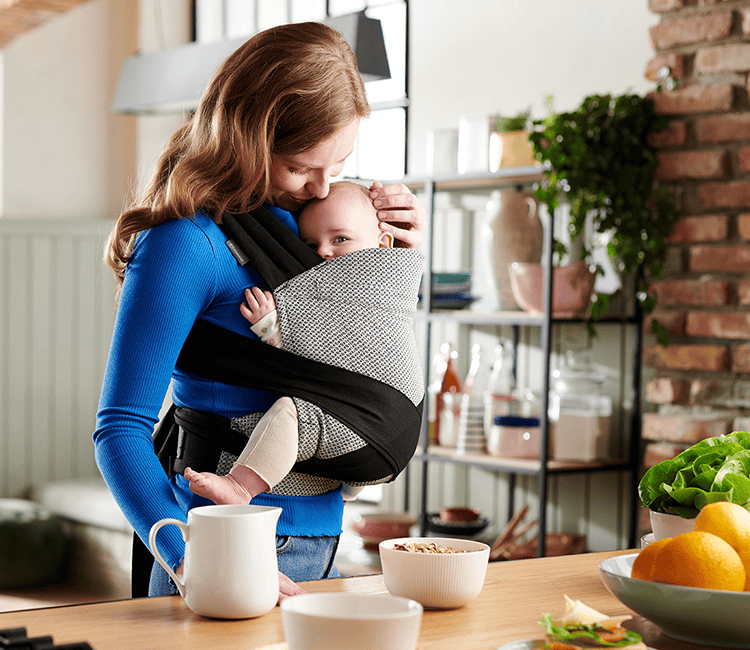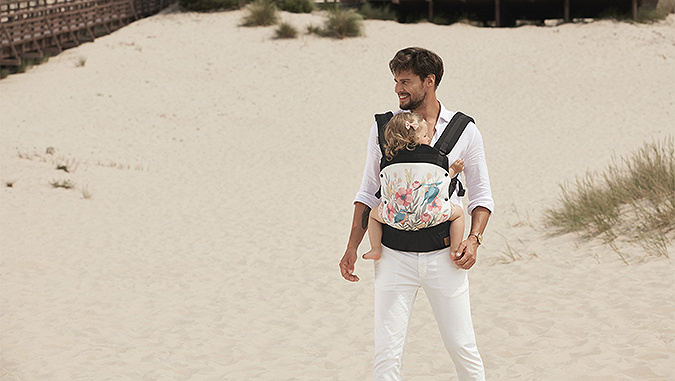Ergonomic baby carrier for toddlers and infants
5 min

Since time immemorial, carrying offspring close to the body has been the most natural form of moving around with a baby and parent-child contact. A stroller was invented relatively recently - the first production of strollers was launched in 1850 in England. Nowadays carrying babies is back in favor, and with it the popularity of various types of baby carriers and slings is growing. Here's what every parent should know about them.
What is a baby carrier?
A baby carrier is a product which enables transporting and carrying a child. Thanks to it, a parent has free hands. It is useful during walks and even longer wanders. It will also prove useful at home during everyday chores, when a baby does not want to just lie down and look around - they want to be carried in arms.
What is worth knowing about baby carriers at the beginning? Why is it worth using them?
It is necessary to pay attention to whether the product we want to buy is certified, safe and ergonomic. The latter feature is especially important for small children, who can't yet sit up on their own. Choose the right product for your child - adjust it to their age (infant or older child) and weight.
Nothing has such a good influence on the child's development as the closeness of the parent. Thanks to the close contact with the mother, a small human being maintains thermal, respiratory and emotional balance, because they do not yet have a self-regulation system. Moro reflex (clenching fists, arms and legs contracture - allows a baby to hold their mom tight in the face of danger) is a remnant of distant ancestors. Men used to lead a nomadic lifestyle, often had to change places and move around with children. Therefore, carrying children on their bodies is the most natural way of functioning together. Carrying a child, we additionally rock them. This is beneficial for babies, as it prolongs sensory stimulation from pregnancy. Close contact with the parent and rocking have a great influence on the physical and mental development of the baby.
When can I use a baby carrier?
Our ergonomic baby carriers can be used from the age of 3 months. Orthopedists and physiotherapists especially recommend slings for parents of smaller babies.
Types of baby carriers
There are many types of baby carriers on the market, they can be divided according to the type of panel that holds the baby. They can be firm or soft, narrow or wide. For the youngest, let's choose only ergonomic ones! It is very important - only they will be safe for your baby.
There are also hybrid mei tai carriers. They are fitted with a tied harness, which is slightly easier to tie than the sling. Our ADOREE carrier falls into this category. It combines the advantages of a sling and a baby carrier, and is perfect for smaller children - it allows them to try the frog leg position. It is easy to fasten and tie (you can tie it in 3 different ways), it has long shoulder straps. In ADOREE you can carry a baby on your stomach or back.
Travel carriers constitute another category. These are special products suitable for mountain hiking. They have a frame which ensures that the child maintains the right position and distributes its weight evenly.
Are baby carriers healthy for children?
Carrier panels which are rigid and too narrow should be avoided when it comes to small children. Such a product may contribute to dysplasia and hip joint dislocations! It is unacceptable that the baby's legs hang inertly, and the whole weight of the body exerts pressure on the crotch and hip joints. Ergonomic carriers are the only choice for babies!
In a safe carrier a baby should have a natural position: frog leg position and back in a C-shape. The panel must be soft and should reach from the border of one popliteal fossa to the other, and the baby's thighs must be supported at full length. The child should be able to bend its legs freely.
Because we care about safety and proper development of our youngest users, all Kinderkraft carriers are ergonomic and certified by IHDI (International Hip Dysplasia Institute). In addition, the MILO carrier received an award for its results in the independent German magazine "Alles Beste" tests.

How to use a baby carrier?
Let's not forget about the parents, their comfort is also important. It is mom or dad's back that will feel the discomfort if the carrier is not adjusted properly. The carrier is attached to the parent's body with straps, so as to evenly distribute the weight of the child. We place the baby in the carrier facing the parent - always "chest to chest". Older children can be carried on the back, also always facing forward.
What else should you pay attention to before buying it?
As we mentioned before, positioning legs in their natural position is very important. That is why, when choosing a carrier for a longer period of time, i.e. one which should "grow" with a child, remember about the possibility of leg space adjustment. The carrier should have the option of adjusting the width of the openings to the age of the child.
It is important that the carrier has both an adjustable waist belt and harness. Then it will be easy to adjust it to people with different figures. Proper width and softness of the waist belt and harness will also have a significant impact on the parents' comfort.
Pay attention to the manufacturer's information about the child's weight. Kinderkraft products can be used by children up to 20 kg! With such a product all longer walks will always be nice - when the child gets tired and wants to be carried.
Other additional facilities offered by manufacturers include a hood for the child, mesh, which will provide adequate ventilation, and practical pockets. All this is included in HUGGY - a reliable ergonomic carrier for all types of weather.
Finally, it is worth mentioning the ease of folding and small size after folding. MILO, NINO and HUGGY carriers easily fit in your bag or backpack.
Baby carriers and breastfeeding
Is breastfeeding in a baby carrier possible? Of course (unless there are contraindications from the manufacturer). But it does require some practice. Mothers must also remember a few important things.
The baby's head has to be at the right height. The harness should be loosened in such a way that the baby's mouth is at the nipple level. Mom may also loosen the waist belt, to move the center of gravity lower.
Important! The mother should be standing or sitting stably during feeding, to minimize the risk of tripping, and the baby should have a free air inflow. The baby's head must not be pressed against the chest and the baby's face must be visible at all times. Ideally, the mother should hold the baby's head and neck with one hand and feed him or her with the other.
|
Did you know that.. Keeping the baby in direct, close contact with the mother increases the level of prolactin - it stimulates lactation! Moms, carry and cuddle your babies! |
How to dress a baby in a baby carrier?
Dress your baby appropriately for the weather, but remember that the carrier is like one layer of clothing. In summer protect the delicate baby body from overheating. It is important that the clothes are loose, not tight. Make sure that the baby's head is protected from strong sun. In cold seasons dress the baby in layers. Dressing the baby in a thick jacket or a big winter suit is pointless - proper placing in the carrier will be impossible. Attention: protect the baby's legs and head from the cold.
